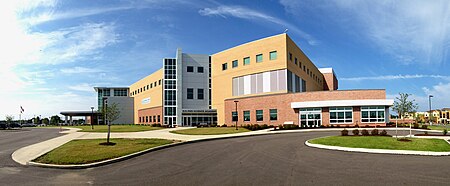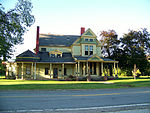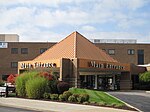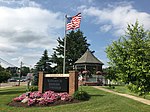Bio-Med Science Academy

Bio-Med Science Academy is a public STEM+M (Science, Technology, Engineering, Mathematics, plus Medicine) school in Portage County, Ohio, United States. The school's original location, now known as the Rootstown campus, is on the campus of Northeast Ohio Medical University (NEOMED) in Rootstown, and houses grades 7 through 12. The school, originally a grades 9–12 high school, has expanded to include lower grade levels, with grades 5 and 6 at its Ravenna campus and grades K-4 at the Shalersville campus. Bio-Med opened as a community charter school in August 2012, but in April 2013 the school received a formal STEM designation for the State of Ohio. This new designation required the closing of the community school which occurred June 30, 2013, and the opening of Bio-Med Science Academy STEM School on July 1, 2013. With its new title it became an official independent and public STEM school.The academy began with an initial freshmen class of 70 students. 119 students were admitted for the 2013–14 academic year, 109 were accepted for the 2014–15 year and 110 for the 2015–16 year. For the 2017–18 school year, Bio-Med expanded to grades 6–12 with the opening of the Lower Academy in Shalersville Township. Total enrollment in the academy now surpasses 1,000 students from over 41 district across eight counties. There is a 50/50 male to female ratio.For the 2020–21 year an addition was completed at the Rootstown campus to house 7th and 8th graders who had previously been at the Shalersville campus, making the Shalersville campus open for 2nd, 3rd, and 4th grades while 6th grade was moved to the Ravenna campus with the 5th graders. The school operates on a year-round academic schedule and is a member of the Akron hub of the Ohio Stem Learning Network. The Upper Academy is housed on the third floor of the NEOMED Education and Wellness (NEW) Center, which opened in August 2014. Previously, the school was located in another part of the NEOMED campus for the first two academic years. Bio-Med Science Academy was granted Ohio STEM designation in April 2013. Within its first year, the school claimed first place at the Regional Engineer Career Day. Bio-Med Science Academy was one of seven schools recognized by Ohio Governor John Kasich in January 2017 as a recipient of the governor's innovation awards.
Excerpt from the Wikipedia article Bio-Med Science Academy (License: CC BY-SA 3.0, Authors, Images).Bio-Med Science Academy
Loretta Drive,
Geographical coordinates (GPS) Address Website Nearby Places Show on map
Geographical coordinates (GPS)
| Latitude | Longitude |
|---|---|
| N 41.103031 ° | E -81.245378 ° |
Address
Northeast Ohio Medical University
Loretta Drive
44272
Ohio, United States
Open on Google Maps






